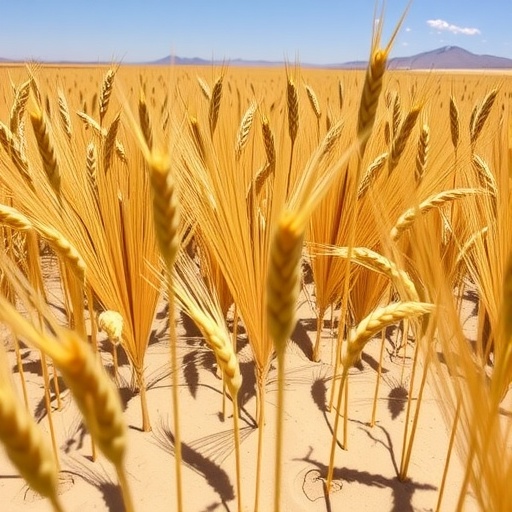In the heart of Namibia’s semi-arid landscape, agricultural scientists are honing in on the crucial interplay between soil health and crop productivity. A recent study conducted by Haufiku, Ausiku, and Huttunen explores this dynamic through a comprehensive analysis of organic and inorganic soil amendments, focusing specifically on their effects on the physico-chemical properties of soil and, consequently, the agronomic performance of wheat (Triticum aestivum L.). This review sheds light on the potential of these amendments to transform the agricultural landscape of a region challenged by climatic adversities.
Semi-arid regions like North-Central Namibia face unique challenges due to low rainfall, which drastically affects soil moisture content and nutrient availability. Typically, such conditions lead to poor crop yields, threatening food security and economic stability for local farmers. By investigating the properties and effects of various soil amendments, researchers aim to equip farmers with tools that can enhance both soil quality and crop productivity, ultimately improving livelihoods.
Organic amendments, such as compost and manure, contribute significantly to enhancing the soil’s physical properties. The organic matter they introduce can improve soil structure, increasing aeration and drainage, which are essential factors for healthy root development. Moreover, these amendments can enhance the soil’s moisture retention capacity, allowing crops to access water during dry spells—a critical advantage in semi-arid conditions. The long-term addition of organic materials has the potential to transform lifeless soils into fertile grounds for crop production, establishing a sustainable model for agriculture in these climates.
On the other hand, inorganic amendments, like fertilizers, are notable for their immediate ability to supply essential nutrients to the soil. However, their usage poses distinct challenges, primarily concerning soil nutrient imbalances and the potential for detrimental ecological effects, such as waterway contamination through runoff. The study highlights a balanced application strategy, suggesting that integrating both organic and inorganic amendments could provide a more holistic approach to soil management, ensuring both immediate and sustainable agricultural benefits.
The review also delves into the key physical and chemical changes that occur in the soil with the application of these amendments. Improved nutrient availability leads to better plant health, enhancing photosynthesis and growth rates. Moreover, the amendments can alter soil pH levels, which is crucial for nutrient solubility and availability. By understanding these chemical interactions, researchers are better positioned to recommend specific amendment practices tailored for different soil types and cropping systems prevalent in Namibia.
Another significant aspect addressed in the study is the socio-economic implications of adopting soil amendment practices. Farmers with access to knowledge about these amendments are more likely to practice sustainable agriculture, leading to improved yields and, consequently, better income. This uplift can empower local farming communities, providing them with the resources to invest in better techniques, machinery, and crop varieties that further enhance agricultural productivity.
The authors also underscore the role of education and accessibility to these practices. Workshops and training programs tailored for local farmers can help disseminate vital knowledge about soil health and management techniques. As farmers become more informed about the importance of soil amendments, they can make proactive decisions that contribute to their agricultural success and environmental sustainability.
The research emphasizes a collaborative approach, where agricultural scientists partner with local farmers to conduct field trials and collect data that highlights the most effective soil amendment strategies. Such collaborative efforts foster a sense of community and shared purpose, essential for establishing long-lasting agricultural practices that align with the ecological and socio-economic landscape of semi-arid Namibia.
As climate change continues to present unprecedented challenges, understanding and improving soil health becomes paramount. The insights from this study could serve as foundational knowledge needed to adapt farming practices to changing weather patterns, helping to ensure food security in a vulnerable region. Innovations in agronomy, grounded in rigorous scientific research, are critical for creating resilience against climate variability.
In conclusion, the role of organic and inorganic soil amendments represents a beacon of hope for agricultural advancement in semi-arid regions. The potential benefits extend beyond mere crop yield improvements, aiming to reshape the agricultural narrative of North-Central Namibia. As farmers adapt these practices, they cultivate not just their fields but also their futures—building a more secure and sustainable tomorrow for themselves and future generations.
While the findings of Haufiku, Ausiku, and Huttunen provide invaluable insights, further research is essential to refine these practices continually. As the agricultural sector evolves, the importance of soil management in promoting sustainable farming cannot be overstated. The promising results from integrating organic and inorganic amendments into farming systems may set a precedent for other regions facing similar climatic challenges around the world.
With collective efforts and commitment to advancing agricultural science, the path forward for Namibia’s farming communities appears promising. Ensuring access to knowledge, resources, and suitable tools for soil amendment will be pivotal in steering this agricultural transformation. The potential for a thriving agricultural landscape in this semi-arid region is within reach, driven by innovation, research, and a united effort towards sustainability.
Subject of Research: The impact of organic and inorganic soil amendments on soil physicochemical properties and wheat agronomic performance in semi-arid North-Central Namibia.
Article Title: The role of organic and inorganic soil amendments on soil physicochemical properties and wheat (Triticum aestivum L.) agronomic performance in Semi-arid North-Central Namibia: A Review.
Article References:
Haufiku, A.M., Ausiku, P.A. & Huttunen, S. The role of organic and inorganic soil amendments on soil physicochemical properties and wheat (Triticum aestivum L.) agronomic performance in Semi-arid North-Central Namibia: A Review.
Discov Agric 3, 215 (2025). https://doi.org/10.1007/s44279-025-00383-5
Image Credits: AI Generated
DOI:
Keywords: Soil amendments, organic, inorganic, wheat, semi-arid, Namibia, agricultural performance, sustainable practices, soil health.
Tags: agricultural productivity in semi-arid regionscrop yield improvement strategieseffects of compost on soil propertiesenhancing wheat yields through soil managementfood security and economic stability in Namibiaimproving soil health in Namibianutrient availability in arid climatesorganic and inorganic soil amendmentsovercoming low rainfall challenges in agriculturerole of organic matter in soil qualitysoil amendments for wheat productionsustainable farming practices in Namibia





